oil temperature CHEVROLET KODIAK 2009 Owners Manual
[x] Cancel search | Manufacturer: CHEVROLET, Model Year: 2009, Model line: KODIAK, Model: CHEVROLET KODIAK 2009Pages: 376, PDF Size: 5.39 MB
Page 4 of 376

Vehicle Symbol Chart
Here are some additional symbols that may be found on
the vehicle and what they mean. For more information
on the symbol, refer to the index.
9:Airbag Readiness Light
#:Air Conditioning
!:Antilock Brake System (ABS)
g:Audio Steering Wheel Controls or OnStar®
$:Brake System Warning Light
":Charging System
I:Cruise Control
B:Engine Coolant Temperature
O:Exterior Lamps
#:Fog Lamps
.:Fuel Gage
+:Fuses
i:Headlamp High/Low-Beam Changer
j:LATCH System Child Restraints
*:Malfunction Indicator Lamp
::Oil Pressure
}:Power
/:Remote Vehicle Start
>:Safety Belt Reminders
7:Tire Pressure Monitor
F:Traction Control
M:Windshield Washer Fluid
iv
Page 79 of 376
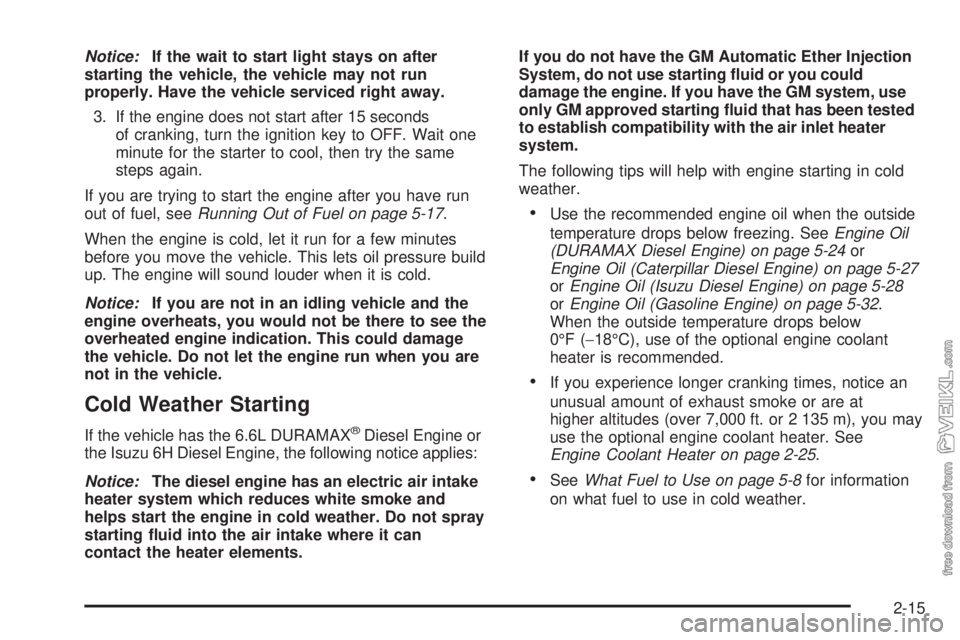
Notice:If the wait to start light stays on after
starting the vehicle, the vehicle may not run
properly. Have the vehicle serviced right away.
3. If the engine does not start after 15 seconds
of cranking, turn the ignition key to OFF. Wait one
minute for the starter to cool, then try the same
steps again.
If you are trying to start the engine after you have run
out of fuel, seeRunning Out of Fuel on page 5-17.
When the engine is cold, let it run for a few minutes
before you move the vehicle. This lets oil pressure build
up. The engine will sound louder when it is cold.
Notice:If you are not in an idling vehicle and the
engine overheats, you would not be there to see the
overheated engine indication. This could damage
the vehicle. Do not let the engine run when you are
not in the vehicle.
Cold Weather Starting
If the vehicle has the 6.6L DURAMAX®Diesel Engine or
the Isuzu 6H Diesel Engine, the following notice applies:
Notice:The diesel engine has an electric air intake
heater system which reduces white smoke and
helps start the engine in cold weather. Do not spray
starting fluid into the air intake where it can
contact the heater elements.If you do not have the GM Automatic Ether Injection
System, do not use starting fluid or you could
damage the engine. If you have the GM system, use
only GM approved starting fluid that has been tested
to establish compatibility with the air inlet heater
system.
The following tips will help with engine starting in cold
weather.
•Use the recommended engine oil when the outside
temperature drops below freezing. SeeEngine Oil
(DURAMAX Diesel Engine) on page 5-24or
Engine Oil (Caterpillar Diesel Engine) on page 5-27
orEngine Oil (Isuzu Diesel Engine) on page 5-28
orEngine Oil (Gasoline Engine) on page 5-32.
When the outside temperature drops below
0°F (−18°C), use of the optional engine coolant
heater is recommended.
•If you experience longer cranking times, notice an
unusual amount of exhaust smoke or are at
higher altitudes (over 7,000 ft. or 2 135 m), you may
use the optional engine coolant heater. See
Engine Coolant Heater on page 2-25.
•SeeWhat Fuel to Use on page 5-8for information
on what fuel to use in cold weather.
2-15
Page 80 of 376
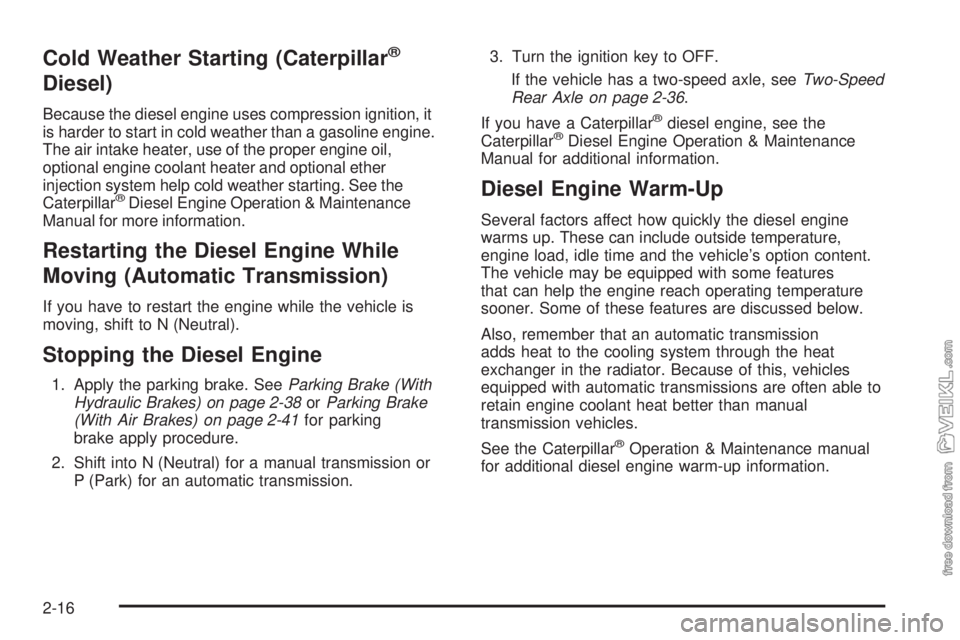
Cold Weather Starting (Caterpillar®
Diesel)
Because the diesel engine uses compression ignition, it
is harder to start in cold weather than a gasoline engine.
The air intake heater, use of the proper engine oil,
optional engine coolant heater and optional ether
injection system help cold weather starting. See the
Caterpillar
®Diesel Engine Operation & Maintenance
Manual for more information.
Restarting the Diesel Engine While
Moving (Automatic Transmission)
If you have to restart the engine while the vehicle is
moving, shift to N (Neutral).
Stopping the Diesel Engine
1. Apply the parking brake. SeeParking Brake (With
Hydraulic Brakes) on page 2-38orParking Brake
(With Air Brakes) on page 2-41for parking
brake apply procedure.
2. Shift into N (Neutral) for a manual transmission or
P (Park) for an automatic transmission.3. Turn the ignition key to OFF.
If the vehicle has a two-speed axle, seeTwo-Speed
Rear Axle on page 2-36.
If you have a Caterpillar
®diesel engine, see the
Caterpillar®Diesel Engine Operation & Maintenance
Manual for additional information.
Diesel Engine Warm-Up
Several factors affect how quickly the diesel engine
warms up. These can include outside temperature,
engine load, idle time and the vehicle’s option content.
The vehicle may be equipped with some features
that can help the engine reach operating temperature
sooner. Some of these features are discussed below.
Also, remember that an automatic transmission
adds heat to the cooling system through the heat
exchanger in the radiator. Because of this, vehicles
equipped with automatic transmissions are often able to
retain engine coolant heat better than manual
transmission vehicles.
See the Caterpillar
®Operation & Maintenance manual
for additional diesel engine warm-up information.
2-16
Page 82 of 376
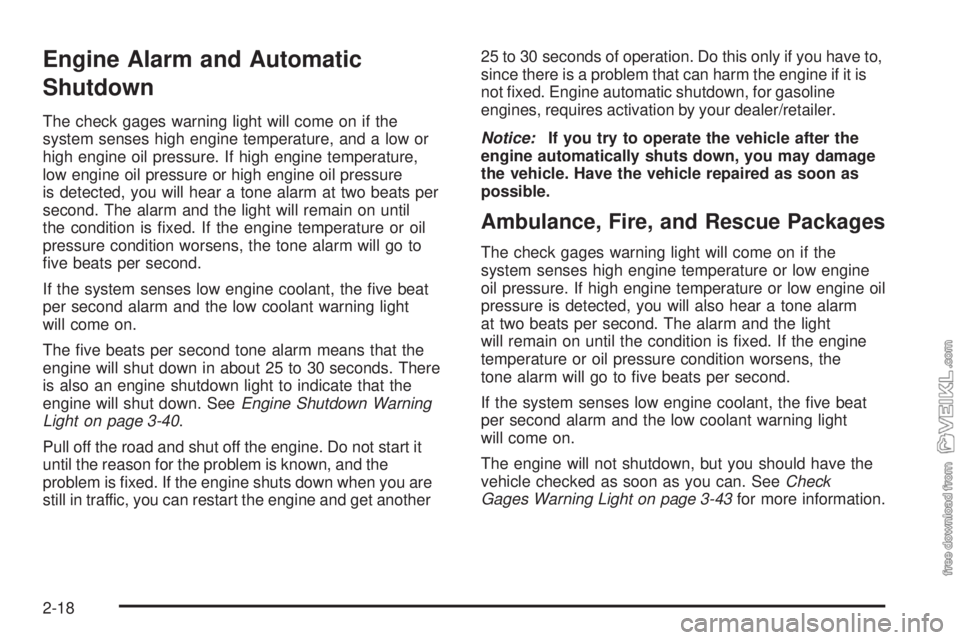
Engine Alarm and Automatic
Shutdown
The check gages warning light will come on if the
system senses high engine temperature, and a low or
high engine oil pressure. If high engine temperature,
low engine oil pressure or high engine oil pressure
is detected, you will hear a tone alarm at two beats per
second. The alarm and the light will remain on until
the condition is fixed. If the engine temperature or oil
pressure condition worsens, the tone alarm will go to
five beats per second.
If the system senses low engine coolant, the five beat
per second alarm and the low coolant warning light
will come on.
The five beats per second tone alarm means that the
engine will shut down in about 25 to 30 seconds. There
is also an engine shutdown light to indicate that the
engine will shut down. SeeEngine Shutdown Warning
Light on page 3-40.
Pull off the road and shut off the engine. Do not start it
until the reason for the problem is known, and the
problem is fixed. If the engine shuts down when you are
still in traffic, you can restart the engine and get another25 to 30 seconds of operation. Do this only if you have to,
since there is a problem that can harm the engine if it is
not fixed. Engine automatic shutdown, for gasoline
engines, requires activation by your dealer/retailer.
Notice:If you try to operate the vehicle after the
engine automatically shuts down, you may damage
the vehicle. Have the vehicle repaired as soon as
possible.
Ambulance, Fire, and Rescue Packages
The check gages warning light will come on if the
system senses high engine temperature or low engine
oil pressure. If high engine temperature or low engine oil
pressure is detected, you will also hear a tone alarm
at two beats per second. The alarm and the light
will remain on until the condition is fixed. If the engine
temperature or oil pressure condition worsens, the
tone alarm will go to five beats per second.
If the system senses low engine coolant, the five beat
per second alarm and the low coolant warning light
will come on.
The engine will not shutdown, but you should have the
vehicle checked as soon as you can. SeeCheck
Gages Warning Light on page 3-43for more information.
2-18
Page 88 of 376

During this warm-up period, check the warning lights
and gages:
•If oil pressure does not begin to rise within
15 seconds of starting, stop the engine and find the
cause. SeeOil Pressure Gage on page 3-38for
more information.
•If the engine coolant temperature gage needle goes
into the hot area on the gage, stop the engine and
find the cause of the overheating. SeeEngine
Coolant Temperature Gage on page 3-34for more
information.
•If you have air brakes, the dual-needle air pressure
gage should read at least 115 psi (790 kPa) for both
service systems before you try to move the vehicle.
When air pressure is below 60 psi (420 kPa), the
LOW AIR light will come on and you will hear a
tone alarm. SeeBrake System Warning Light on
page 3-31for more information. If the pressure does
not build up or drops during warm-up, stop the
engine and find the cause before you try to move the
vehicle. Recommended air pressure before driving is
120 psi (830 kPa). SeeAir Pressure Gage on
page 3-47for more information.
•The charging system light should come on when the
ignition key is turned to ON/RUN or START and
should go out when the engine is running above idle.
If the light does not go out or comes back on during
normal engine operation, have the charging system
checked right away. (This light tells you if the
generator is not charging; it does not reflect the
condition of the battery.) SeeCharging System Light
on page 3-29for more information.
•The voltmeter charge indicator gage tells you the
condition of the battery’s charge. The gage should be
in the center area during engine operation. The red
area on the left indicates an undercharge condition;
the red area on the right indicates an overcharge.
If the gage is in either red area, have the battery and
charging system checked right away. SeeVoltmeter
Gage on page 3-30for more information.
Notice:Do not allow the engine to operate at low
idle for more than five minutes. This can cause low
engine operating temperatures which can affect
engine operation and reduce engine life. Engine idle
speed should be increased to 1200 rpm whenever
extended idle is required. Once started, the engine
should be placed under load to allow the engine
coolant temperature to reach 150°F (66°C) before
shutting off the engine.
2-24
Page 120 of 376
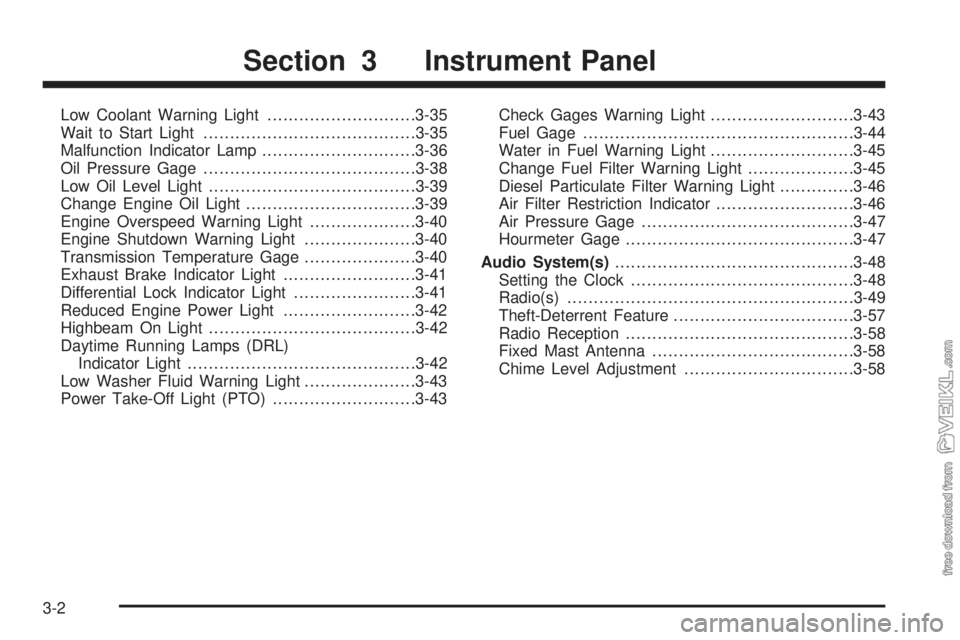
Low Coolant Warning Light............................3-35
Wait to Start Light........................................3-35
Malfunction Indicator Lamp.............................3-36
Oil Pressure Gage........................................3-38
Low Oil Level Light.......................................3-39
Change Engine Oil Light................................3-39
Engine Overspeed Warning Light....................3-40
Engine Shutdown Warning Light.....................3-40
Transmission Temperature Gage.....................3-40
Exhaust Brake Indicator Light.........................3-41
Differential Lock Indicator Light.......................3-41
Reduced Engine Power Light.........................3-42
Highbeam On Light.......................................3-42
Daytime Running Lamps (DRL)
Indicator Light...........................................3-42
Low Washer Fluid Warning Light.....................3-43
Power Take-Off Light (PTO)...........................3-43Check Gages Warning Light...........................3-43
Fuel Gage...................................................3-44
Water in Fuel Warning Light...........................3-45
Change Fuel Filter Warning Light....................3-45
Diesel Particulate Filter Warning Light..............3-46
Air Filter Restriction Indicator..........................3-46
Air Pressure Gage........................................3-47
Hourmeter Gage...........................................3-47
Audio System(s).............................................3-48
Setting the Clock..........................................3-48
Radio(s)......................................................3-49
Theft-Deterrent Feature..................................3-57
Radio Reception...........................................3-58
Fixed Mast Antenna......................................3-58
Chime Level Adjustment................................3-58
Section 3 Instrument Panel
3-2
Page 156 of 376

Oil Pressure Gage
The engine oil pressure
gage, on the lower right
portion of your instrument
panel cluster, shows
engine oil pressure in psi
(pounds per square inch) or
in kPa (kilopascals).
Oil pressure may vary with outside temperature and oil
viscosity, but readings of 30 to 40 psi (205 to 275 kPa)
on gasoline engines at operating temperature and
moderate road speeds are normal. If you have a diesel
engine, the normal operating range should be between
35 and 70 psi (240 to 480 kPa).A reading in the low pressure zone may be caused by a
dangerously low oil level or other problem.
If you have a Caterpillar®diesel engine, also see your
Caterpillar®Operation & Maintenance Manual.
{CAUTION:
Do not keep driving if the oil pressure is low. The
engine can become so hot that it catches fire.
Someone could be burned. Check the oil as soon
as possible and have the vehicle serviced.
Notice:Lack of proper engine oil maintenance can
damage the engine. The repairs would not be
covered by the vehicle warranty. Always follow the
maintenance schedule in this manual for changing
engine oil.
3-38
Page 158 of 376
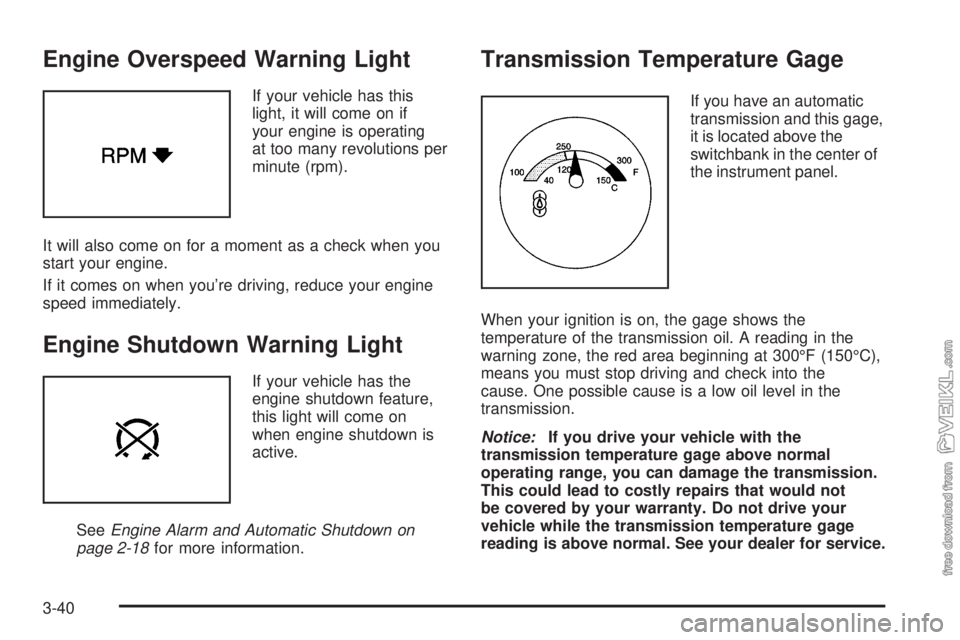
Engine Overspeed Warning Light
If your vehicle has this
light, it will come on if
your engine is operating
at too many revolutions per
minute (rpm).
It will also come on for a moment as a check when you
start your engine.
If it comes on when you’re driving, reduce your engine
speed immediately.
Engine Shutdown Warning Light
If your vehicle has the
engine shutdown feature,
this light will come on
when engine shutdown is
active.
SeeEngine Alarm and Automatic Shutdown on
page 2-18for more information.
Transmission Temperature Gage
If you have an automatic
transmission and this gage,
it is located above the
switchbank in the center of
the instrument panel.
When your ignition is on, the gage shows the
temperature of the transmission oil. A reading in the
warning zone, the red area beginning at 300°F (150°C),
means you must stop driving and check into the
cause. One possible cause is a low oil level in the
transmission.
Notice:If you drive your vehicle with the
transmission temperature gage above normal
operating range, you can damage the transmission.
This could lead to costly repairs that would not
be covered by your warranty. Do not drive your
vehicle while the transmission temperature gage
reading is above normal. See your dealer for service.
3-40
Page 161 of 376

Low Washer Fluid Warning Light
This light is located above
the climate controls in the
center of the instrument
panel.
This light will come on when your vehicle is low on
windshield washer fluid.
For more information, seeWindshield Washer Fluid on
page 5-50.
Power Take-Off Light (PTO)
For vehicles with Power
Take-Off (PTO), this light
is located in the center
of the instrument panel.
This light will come on when the PTO switch is in the
ON/RUN position. SeePower Take-Off (PTO) on
page 2-30for more information.
Check Gages Warning Light
This light will come on
briefly when the engine is
started.
If this light comes on and stays on while you are driving.
It means that either the engine coolant temperature
gage or the engine oil pressure gage may be showing a
reading in the warning zone.
When the check gages light comes on, you will also
hear a warning tone. The tone and the light will
stay activated until the problem is corrected.
This light may also come on if your vehicle is has
automatic engine shutdown system and engine
shutdown has begun. SeeEngine Alarm and Automatic
Shutdown on page 2-18.
3-43
Page 211 of 376
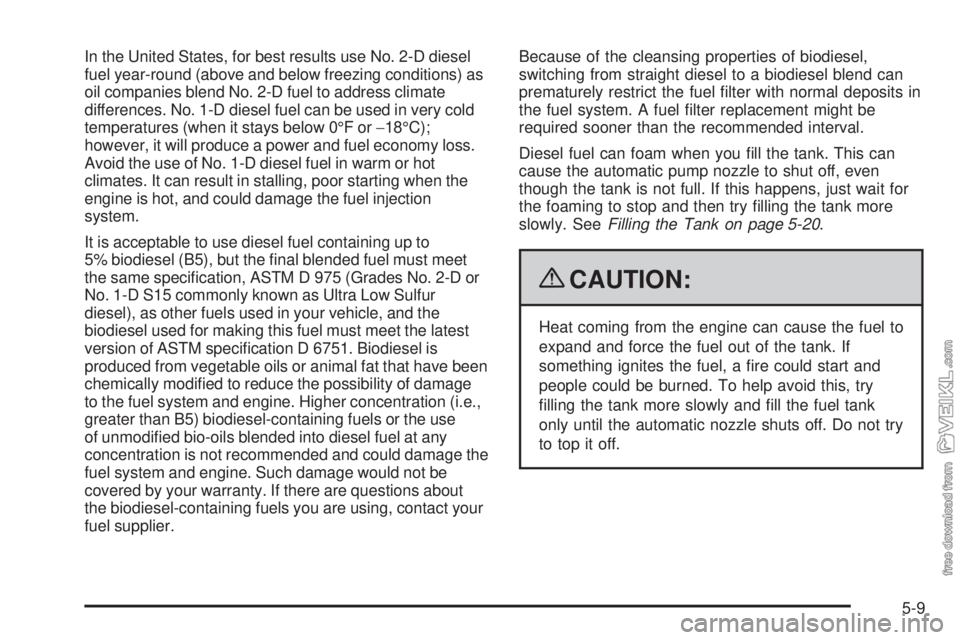
In the United States, for best results use No. 2-D diesel
fuel year-round (above and below freezing conditions) as
oil companies blend No. 2-D fuel to address climate
differences. No. 1-D diesel fuel can be used in very cold
temperatures (when it stays below 0°F or−18°C);
however, it will produce a power and fuel economy loss.
Avoid the use of No. 1-D diesel fuel in warm or hot
climates. It can result in stalling, poor starting when the
engine is hot, and could damage the fuel injection
system.
It is acceptable to use diesel fuel containing up to
5% biodiesel (B5), but the final blended fuel must meet
the same specification, ASTM D 975 (Grades No. 2-D or
No. 1-D S15 commonly known as Ultra Low Sulfur
diesel), as other fuels used in your vehicle, and the
biodiesel used for making this fuel must meet the latest
version of ASTM specification D 6751. Biodiesel is
produced from vegetable oils or animal fat that have been
chemically modified to reduce the possibility of damage
to the fuel system and engine. Higher concentration (i.e.,
greater than B5) biodiesel-containing fuels or the use
of unmodified bio-oils blended into diesel fuel at any
concentration is not recommended and could damage the
fuel system and engine. Such damage would not be
covered by your warranty. If there are questions about
the biodiesel-containing fuels you are using, contact your
fuel supplier.Because of the cleansing properties of biodiesel,
switching from straight diesel to a biodiesel blend can
prematurely restrict the fuel filter with normal deposits in
the fuel system. A fuel filter replacement might be
required sooner than the recommended interval.
Diesel fuel can foam when you fill the tank. This can
cause the automatic pump nozzle to shut off, even
though the tank is not full. If this happens, just wait for
the foaming to stop and then try filling the tank more
slowly. SeeFilling the Tank on page 5-20.
{CAUTION:
Heat coming from the engine can cause the fuel to
expand and force the fuel out of the tank. If
something ignites the fuel, a fire could start and
people could be burned. To help avoid this, try
filling the tank more slowly and fill the fuel tank
only until the automatic nozzle shuts off. Do not try
to top it off.
5-9